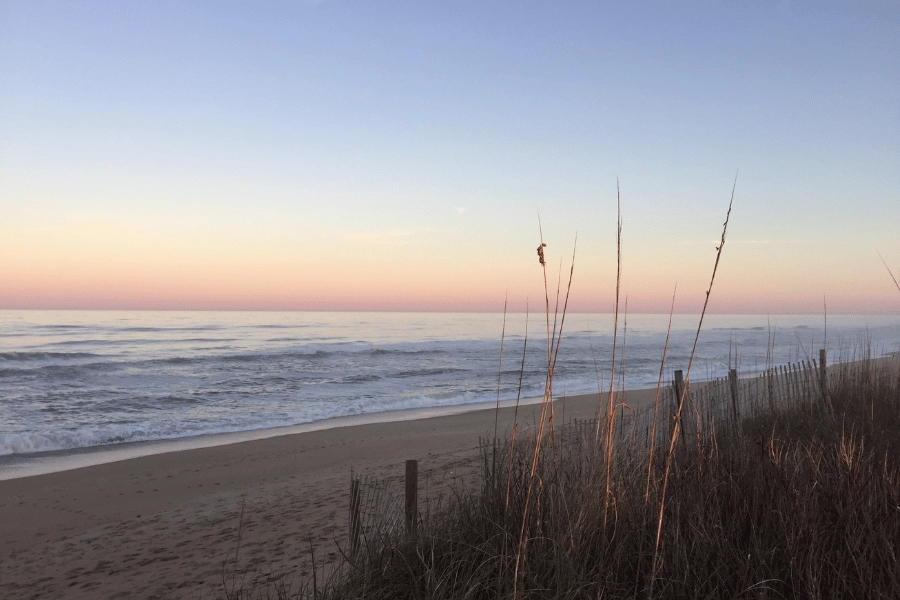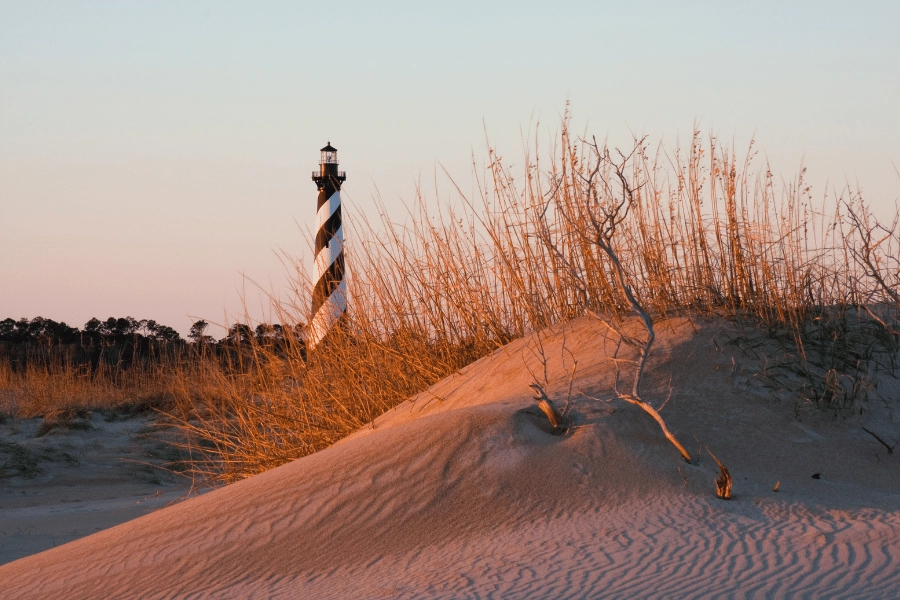Your Complete Guide to OBX
Are you planning a road trip from the Triangle area to the Outer Banks? Here is what you need to know to create the best trip to the Outer Banks!
The Outer Banks, also known as OBX, is a 200-mile stretch of barrier islands located off the coast of North Carolina and the coast of Southeastern Virginia. Every Summer, thousands of visitors flock to the Outer Banks for sand and sun.
For Raleigh residents, this barrier island paradise is one of North Carolina's greatest treasures. Just a few hours from the hustle of Raleigh-Durham-Chapel Hill, the Outer Banks offers a world of windswept beaches, wild horses, and historic lighthouses.
If you start your trip from the Triangle area, you will enter the Outer Banks through Roanoke Island. From there, you can decide to explore other famous beaches such as Nags Head, Kill Devil Hills, Kitty Hawk, and Corolla.
Whether you're a longtime North Carolinian or new to the Triangle area, planning the perfect Outer Banks getaway requires more than just throwing a beach bag in the car.
From navigating the best routes and timing your visit to avoid summer traffic, to discovering hidden gems beyond the typical tourist stops, this guide will help you make the most of your coastal escape.
So, if you are looking for an escape from the big city, take the four-hour trip to reach this popular vacation getaway. Keep reading to learn more about everything you should do on your road trip to the Outer Banks.
Here is the ultimate Outer Banks road trip guide from the Triangle.
1. Getting There
From Raleigh, your most straightforward path to the Outer Banks takes you east on US-64, a scenic route that gradually transitions from piedmont pines to coastal flatlands. The journey is approximately 180-200 miles (3.5 to 4 hours), depending on your final OBX destination.
Pro Tips for Triangle Travelers:
- Leave Raleigh early (before 8 AM on weekends) to beat beach traffic and arrive in time for lunch with an ocean view
- Gas up before you reach the bridges since fuel is noticeably more expensive on the barrier islands
- Download offline maps, as cell service can be spotty through the Alligator River National Wildlife Refuge
- Pack snacks and water; once you leave Rocky Mount, your dining options become limited until you reach the coast
- Consider taking NC-12 north to Corolla or south to Hatteras since this scenic coastal highway offers stunning water views on both sides
- Stop by the visitor center, which offers a lot of information about the area from locals.
Seasonal Considerations:
Summer weekends can add 1-2 hours to your drive time due to beach traffic, particularly on Friday afternoons and Sunday evenings. Consider traveling mid-week or timing your departure to avoid peak congestion hours (3-7 PM on Fridays).
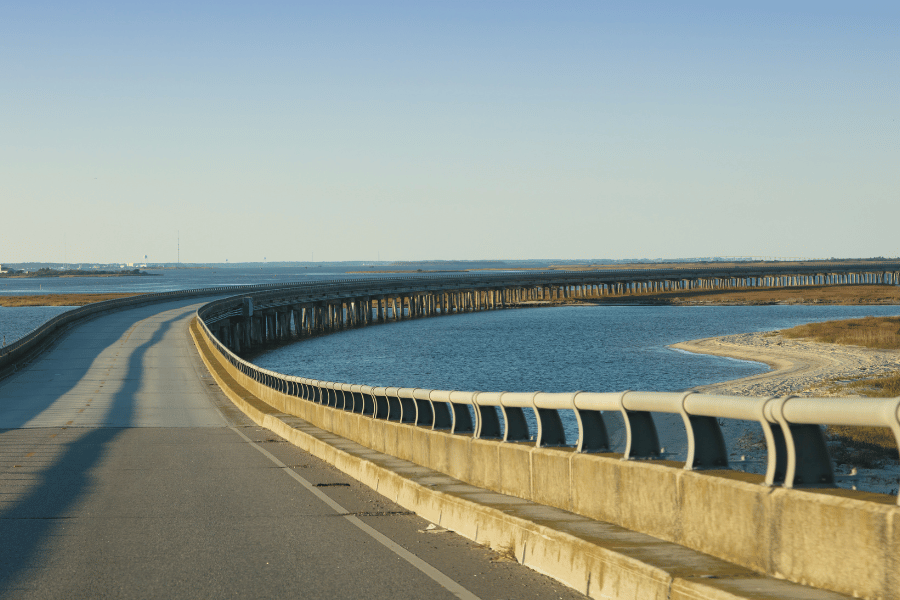
2. Best Time to Visit the Outer Banks from the Triangle
Living in the Triangle gives us the luxury of being close enough to visit the Outer Banks year-round, and each season offers its own unique appeal and weather:
Late Spring (May-Early June)
Late spring is the sweet spot for many Triangle residents. Ocean temperatures start becoming swimmable (upper 60s to low 70s), crowds are manageable, and accommodation rates haven't hit peak summer prices. This is ideal for families with school-age children looking to squeeze in a pre-summer break getaway.
Summer (Mid-June through August)
Peak season brings warm waters (mid-70s to low 80s), bustling beaches, and the full OBX experience. This is also the time for the largest crowds and highest prices. Book accommodations months in advance, and consider visiting popular attractions early in the morning. The Triangle's proximity means you can opt for mid-week trips when crowds thin considerably.
Early Fall (September-October)
Perhaps the best-kept secret for Triangle travelers. The ocean is at its warmest, and the crowds disappear after Labor Day. You will find better deals on accommodations and enjoy a more relaxed, local atmosphere. The weather remains beautiful, with highs in the 70s and 80s.
Winter (November-March)
For those seeking solitude and dramatic coastal beauty, winter offers near-empty beaches, excellent fishing, and significant savings on lodging. While swimming is out, the Outer Banks in winter has a haunting beauty.
Bundle up for beach walks, visit historic sites without crowds, and enjoy cozy fireside dinners at local restaurants. This is when the OBX truly belongs to those who appreciate its wild, untamed nature.
3. Must-Visit Destinations in the Outer Banks
It can be challenging to fit in all the attractions, historical sites, and fun activities when vacationing in the Outer Banks, as there are numerous places to visit. To get the best of your time here, plan to visit these must-see destinations:
Corolla Wild Horses
One of the Outer Banks' most enchanting experiences awaits on the 4WD beaches north of Corolla. Approximately 100 wild Spanish Mustangs roam freely along this pristine stretch of coastline, descendants of horses brought by Spanish explorers in the 1500s.
To access this area, you'll need a 4WD vehicle and a permit (available at local shops). Air down your tires to 15-20 PSI, stay on established tracks, and maintain a respectful distance from the horses since these are wild animals protected by federal law.
Book a guided wild horse tour if you don't have 4WD access. Local outfitters offer safari-style tours in large 4x4 vehicles, providing historical context and ensuring safe, responsible wildlife viewing.
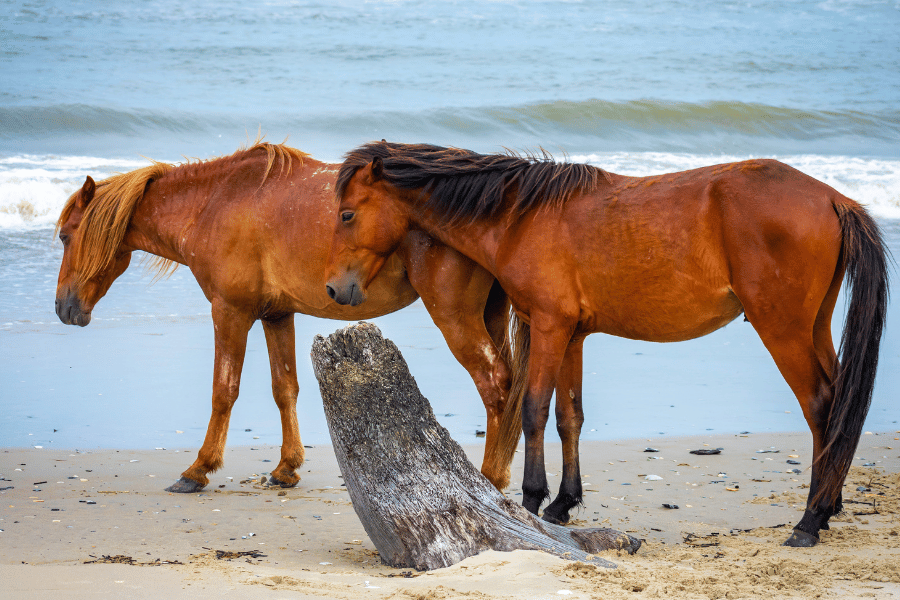
Currituck Beach Lighthouse
This stunning brick lighthouse is the most distinctive of the four lighthouses stationed throughout the Outer Banks. With its natural red color, this lighthouse stands 162 feet tall and offers panoramic views after climbing 220 steps.
Unlike its painted cousins to the south, Currituck's lighthouse was left unpainted to distinguish it from other lighthouses along the coast. The surrounding Currituck Heritage Park includes beautiful grounds perfect for picnicking, and the adjacent Whalehead Club offers tours showcasing the Gilded Age history of the Outer Banks.
Historic Corolla Park
Historic Corolla Park is a charming village center that maintains the authentic character of old Corolla, with restored historic buildings including the original lighthouse keeper's quarters, schoolhouse, and various outbuildings. It's a photographer's dream and offers a glimpse into life in this remote outpost before the bridges connected the Outer Banks to the mainland.
Duck
This upscale village offers sophisticated dining, boutique shopping, and the popular Duck Town Boardwalk is a mile-long waterfront path along Currituck Sound, perfect for sunset strolls.
Duck maintains a more refined, quieter atmosphere compared to bustling Nags Head, making it ideal for romantic getaways or those seeking a more relaxed pace.
Wright Brothers National Memorial
Standing atop Kill Devil Hill, where Orville and Wilbur Wright achieved the first powered flight in 1903, you'll gain a profound appreciation for this pivotal moment in human history at the Wright Brothers National Memorial.
The museum features replica aircraft, and markers on the field show the distances of the first four flights. The monument itself offers excellent views of the surrounding area. As Triangle residents, we can appreciate that North Carolina's "First in Flight" motto connects directly to this hallowed ground.
Jockey's Ridge State Park
Home to the tallest natural sand dune system in the Eastern United States, Jockey's Ridge is spectacular at sunset. The massive dunes shift and change with the winds, creating an otherworldly landscape.
It's a premier hang-gliding destination (lessons available), and climbing to the top rewards you with 360-degree views of both the Atlantic Ocean and Currituck Sound. Bring water and wear closed-toe shoes—the sand gets scorching hot in summer.

Nags Head
The most developed beach community offers excellent restaurant variety, shopping at Tanger Outlets, and the historic Nags Head Pier, which is perfect for fishing or simply watching the waves.
The Nags Head Woods Preserve provides a refreshing escape into a maritime forest with hiking trails that showcase the ecological diversity beyond the beaches.
Manteo
This charming waterfront town serves as the cultural heart of the Outer Banks. Visit the Roanoke Island Festival Park to explore a 16th-century settlement site and walk aboard a representative sailing ship.
The Lost Colony outdoor drama (running since 1937) tells the story of the first English settlement in the New World. Downtown Manteo's boardwalk offers excellent dining and shopping with a more authentic, less touristy feel.
North Carolina Aquarium
The North Carolina Aquarium is one of three state aquariums. This facility features impressive exhibits, including a 285,000-gallon Graveyard of the Atlantic tank with sharks, sea turtles, and stingrays. It's particularly popular with families and offers touch tanks and daily programs.
4. Where to Stay
There are over 340 hotels available in the Outer Banks that vary in price. You may want to stay overnight since there is so much to do in the Outer Banks.
Oceanfront Condos
For Triangle residents who prefer the convenience and amenities of condo living, oceanfront condos offer the best value for families and groups. Most feature full kitchens (save money by cooking some meals), multiple bedrooms, and shared amenities like pools and beach access.
Popular complexes include Sea Scape in Kitty Hawk, Surf Side in Nags Head, and various options in Duck and Corolla. Many Triangle residents return to the same complex year after year, building traditions and familiarity.
Traditional Beach Houses
Nothing says Outer Banks quite like a classic beach house rental, and many Triangle residents purchase one as an investment opportunity. From cozy cottages to massive multi-family compounds, weekly beach house rentals remain the most popular accommodation choice for Triangle residents, especially during summer. Sites like VRBO, Airbnb, and local property management companies offer thousands of options across all price ranges.
Budget-Friendly Options
Chain hotels in Kitty Hawk and Kill Devil Hills offer affordable options for shorter stays or last-minute trips. While they lack the character of beach houses or boutique properties, they provide clean, reliable accommodations with easy beach access. Consider the Comfort Inn, Days Inn, or Quality Inn properties along the Beach Road (NC-12).
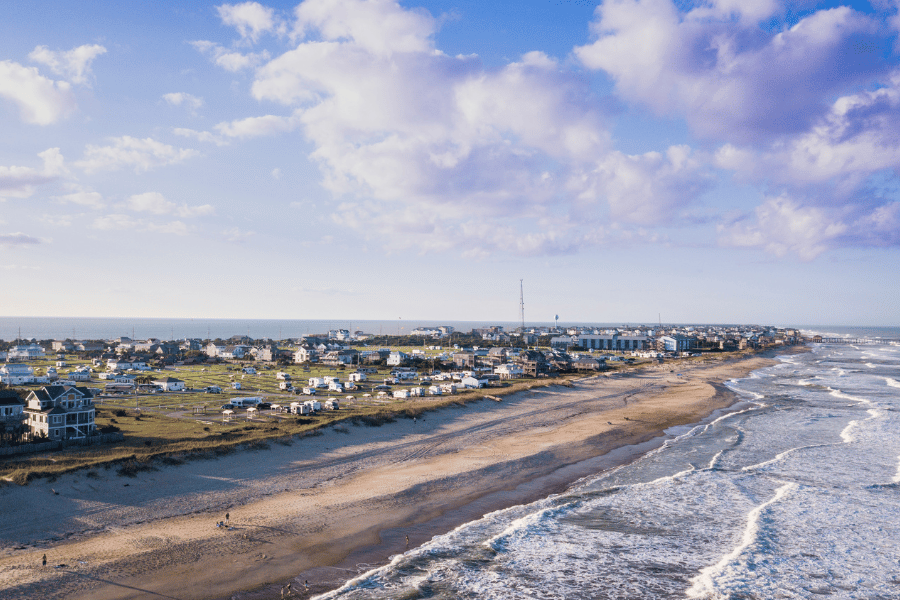
5. Dining Recommendations
The Outer Banks' culinary scene has evolved significantly, now offering everything from casual seafood shacks to upscale dining:
Breakfast Spots:
- Stack 'em High Pancakes (Kitty Hawk): Massive portions, local favorite
- Duck Donuts (Multiple locations): Custom donuts made to order
- The Paper Canoe (Duck): Upscale breakfast in a charming setting
Lunch:
- Tortugas' Lie (Nags Head): Fresh seafood with a fun, casual atmosphere
- Fish Heads Bar & Grill (Corolla): Soundside dining with excellent grouper
- North Banks Restaurant & Raw Bar (Corolla): Coastal cuisine with local seafood
Dinner:
- 1587 Restaurant and Lounge (Manteo): Cozy fine dining
- Basnight's Lone Cedar Café (Nags Head): Soundside sunset dining, fresh catch daily
- Ocean Boulevard (Kitty Hawk): Consistently excellent seafood and steaks
Don't Miss:
- Fresh seafood markets where you can buy local catch to cook at your rental
- OBX Brewing Station for craft beers and pub fare
- Kill Devil's Frozen Custard & Beach Fries for a classic beach treat
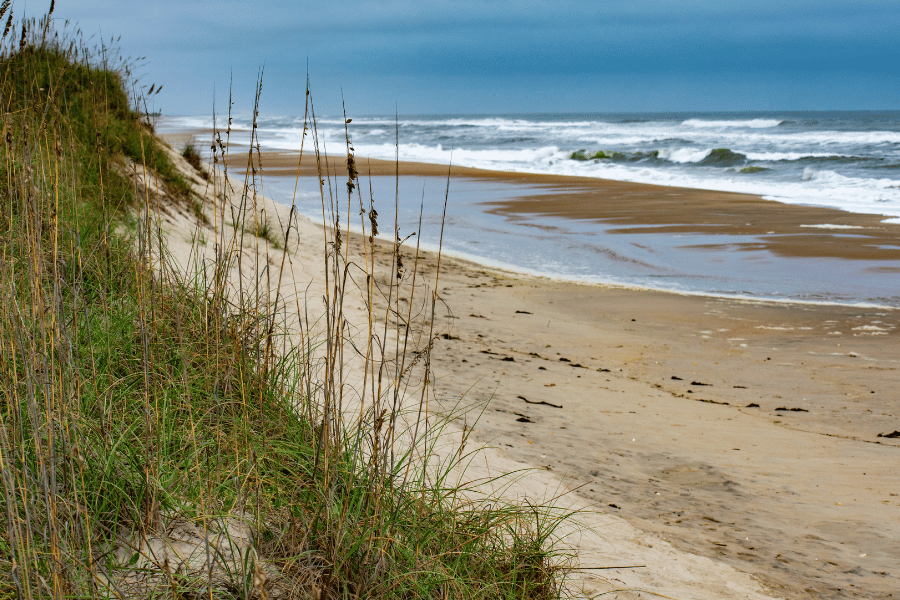
Methodology
Data was sourced from The Outer Banks to determine the ultimate Outer Banks road trip guide from the Triangle.
FAQs
How long does it take to drive the entire Outer Banks?
It usually takes around five hours to drive the entire byway. However, you don't necessarily have to complete the whole route to experience the beauty of the Outer Banks. Along the way, there are plenty of places where you can take breaks and enjoy the many attractions the area has to offer.
Can you drive all the way down the Outer Banks?
Yes, the byway extends for 138 miles and 25 ferry miles, crossing several islands, including Cedar Island, Ocracoke Island, and Hatteras Island.
What is the best way to explore the Outer Banks?
The best way to get around the Outer Banks is by car. The Island stretches over 130 miles, which means all the attractions are spread out. Having a car will make it easier for you to visit each place you want on your own time.
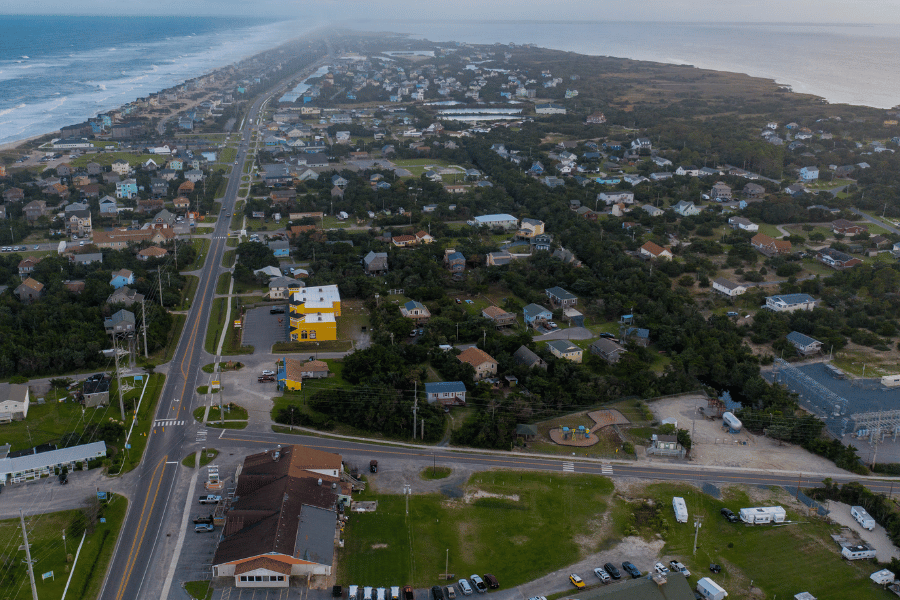
The Ultimate Outer Banks Road Trip From the Triangle - Final Thoughts
From the moment you leave Raleigh's skyline in your rearview mirror to when you first breathe in the salt air, you are experiencing the incredible diversity that makes North Carolina such a special place to call home.
Whether you are watching wild horses gallop across Corolla's beaches, climbing historic lighthouses, conquering the dunes at Jockey's Ridge, or simply settling into a beach chair with nothing but the sound of waves ahead of you, the Outer Banks offers something for every Triangle resident's taste.
The beauty of Raleigh's proximity to the coast is that the Outer Banks can be a weekend escape, a week-long family vacation, a romantic getaway, or a day trip for fresh seafood and coastal air.
As you plan your ultimate Outer Banks road trip, remember that the best trips balance must-see attractions with simple pleasures. The Outer Banks has welcomed visitors for generations, and its timeless appeal continues to draw Triangle residents seeking both adventure and tranquility.
Are you ready to move to Raleigh and make the Triangle your home base for coastal adventures? Contact Raleigh Realty to discover properties that put you within easy reach of both urban excitement and beach relaxation.
